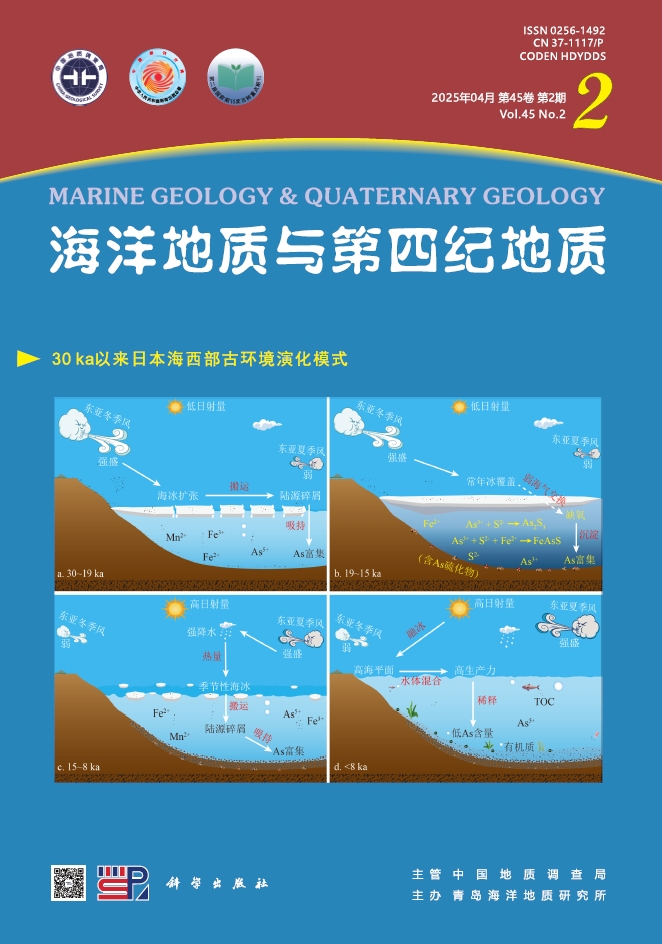| [1] |
Okada H, Honjo S. The distribution of oceanic coccolithophorids in the Pacific[J]. Deep Sea Research and Oceanographic Abstracts, 1973, 20(4):355-364.
Google Scholar
|
| [2] |
Li W T, Okada H. Relations between floral composition of calcareous nannofossils and paleoceanographic environment observed in three piston cores obtained from the equatorial Pacific, East China Sea and Japan Sea[C]. Bull. Yamagata Univ., Nat. Sci., Yamagata, Ⅱ, 1985, 177-191.
Google Scholar
|
| [3] |
Takayanagi Y, Saito T, Okada H, et al. Mid Quaternary paleoceanographic trend in near-shore waters of the northwest Pacific[C]. Tohoku Univ., Sci. Rep., 2nd ser. (Geol.), 1987, 57(2):105-137.
Google Scholar
|
| [4] |
Molfino B, McIntyre A. Nutricline variation in the equatorial Atlantic coincident with the Younger Dryas[J]. Paleoceanography, 1990, 5:997-1008.
Google Scholar
|
| [5] |
Beaufort L, Lancelot Y, Camberlin P, et al. Insolation cycles as a major control of Equatorial Indian Ocean primary production[J]. Science, 1997, 278(21):1451-1454.
Google Scholar
|
| [6] |
Henriksson A S. Coccolithophore response to oceanographic changes in the equatorial Atlantic during the last 200000 years[J]. Palaeogeography, Palaeoclimatology, Palaeoecology, 2000, 156(1-2):161-173.
Google Scholar
|
| [7] |
Beaufort L, Garidel-Thoron T, Mix A C, et al. ENSO-like forcing on oceanic primary production during the Late Pleistocene[J]. Science, 2001, 293(28):2440-2444.
Google Scholar
|
| [8] |
de Garidel-Thoron T, Beaufort L, Linsley B K, et al. Millennial-scale dynamics of the East Asian winter monsoon during the last 200000 years[J]. Palaegeography, 2001, 16:1-12.
Google Scholar
|
| [9] |
刘传联, 成鑫荣. 从超微化石看南沙海区近2 Ma海水上层结构的变化[J]. 中国科学(D辑), 2001, 31(10
Google Scholar
):834-839.[LIU Chuanlian, CHENG Xinrong. Exploring variations in upper ocean structure for the last 2 Ma of the Nansha area by means of calcareous nannofossils[J]. Science in China (Series D), 2001, 44(10):905-911.]
Google Scholar
|
| [10] |
刘传联, 成鑫荣, 王汝建, 等. 西太平洋暖池区第四纪钙质超微化石氧碳同位素特征及意义[J]. 地球科学——中国地质大学学报, 2005, 30(5):559-603.
Google Scholar
[LIU Chuanlian, CHENG Xinrong, WANG Rujian, et al. Oxygen and carbon isotope records of Quaternary calcareous nannofossils from the western Pacific warm pool and their paeloceanographical significance[J]. Earth Science-Journal of China University of Geosciences, 2005, 30(5):559-603.]
Google Scholar
|
| [11] |
赵京涛, 李铁刚, 常凤鸣, 等. 西太平洋暖池核心区MIS 7期以来的古生产力变化:类ENSO式过程的响应[J]. 海洋学报, 2008, 30(3):87-94.
Google Scholar
[ZHAO Jingtao, LI Tiegang, CHANG Fengming, et al. Variations of paleoproductivity in the nuclear region of western Pacific warm pool since MIS 7:response to ENSO-like process[J]. Acta Oceanologica Sinica, 2008, 30(3):87-94.]
Google Scholar
|
| [12] |
Tanaka Y. Calcareous nannoplankton thanatocoenoses in surface sediments from seas around Japan[C]. Sci. Rep. Tohoku Univ., 2nd Ser., 1991. 61:127-198.
Google Scholar
|
| [13] |
Ahagon N, Tanaka Y, Ujiie H.Florisphaera profunda, a possible nannoplankton indicator of late Quaternary changes in sea-water turbidity at the northwestern margin of the Pacific[J]. Marine Micropaleontology, 1993, 22(3):255-273.
Google Scholar
|
| [14] |
Okada H,Matsuoka M. Lower-photic nannoflora as an indicator of the late Quaternary monsoonal palaeo-record in the tropical Indian Ocean[C].//Micro-fossils and Oceanic Environments.Moguilevsky A and Whatley R, 1996, University of Wales:Aberystwyth Press, 231-245.
Google Scholar
|
| [15] |
Martinson D G,Pisias N G, Hays J D, et al. Age dating and the orbital theory of the Ice Ages:Development of a high-resolution 0 to 300000-year chronostratigraphy[J]. Quaternary Researtch, 1987, 27:1-29.
Google Scholar
|
| [16] |
Thompson P R, Be W H A, Duplessy J C, et al. Disappearence of pink-pigmented Globigerina ruber at 120000 yr BP. in the Indian and Pacific Oceans[J]. Nature, 1979, 280:554-558.
Google Scholar
|
| [17] |
Kawahata H,Ohshima H. Vegetation and environmental record in the northern East China Sea during the Late Pleistocene[J]. Global and Planetary Change, 2004, 41:251-273.
Google Scholar
|
| [18] |
Oba T.Paleoenvironmental change of the Kuroshio region of Japan since the last glacial age[C]. Global Fluxes of Carbon and Its Substances in the Coastal Sea-Ocean-Atmosphere System,Tsunogai S, 1995, 478-486.
Google Scholar
|
| [19] |
Ijiri A,Wang L J, Oba T, et al. Paleoenvironmental changes in the northern area of the East China Sea during the past 42000 years[J]. Palaegeography, Paleoclimatology, Paleoecology, 2005, 219:239-261.
Google Scholar
|
| [20] |
Xu XD,Oda M. Surface-water evolution of the eastern East China Sea during the last 36000 years[J]. Marine Geology, 1999, 156:285-304.
Google Scholar
|
| [21] |
Ujiie H,Ujiie Y. Late Quaternary course changes of the Kuroshio Current in the Ryukyu Arc region, northweatern Pacific Ocean[J]. Marine and Micropaleontology, 1999, 37(1):23-40.
Google Scholar
|
| [22] |
Jian Z,Wang P, Saito Y, et al. Holocene variability of the Kuroshio current in the Okinawa Trough, northweatern Pacific Ocean[J]. Earth and Planetary Science Letters, 2000, 184(1):305-319.
Google Scholar
|
| [23] |
Wyrtki K.El Niño-the dynamic response of the equatorial Pacific Ocean to atmosphere forcing[J]. Journal of Physical Oceanography, 1975, 5:572-584.
Google Scholar
|
| [24] |
赵京涛, 李铁刚, 常凤鸣, 等. 近190 kaBP以来西太平洋暖池北缘上层海水结构和古生产力演化特征及其控制因素:来自钙质超微化石和有孔虫的证据[J]. 海洋与湖沼, 2008, 39(4):305-311.
Google Scholar
[ZHAO Jingtao, Li Tiegang, CHANG Fengming, et al. Evolution in upper water structure and paleoproductivity in the northern margin of western Pacific warm pool and its forcing mechanism during the last 190 kaBP:evidence from nannofossil, foraminifera and their isotope composition[J]. Oceanologia et Limnologia Sinica, 2008, 39(4):305-311.]
Google Scholar
|






 DownLoad:
DownLoad: